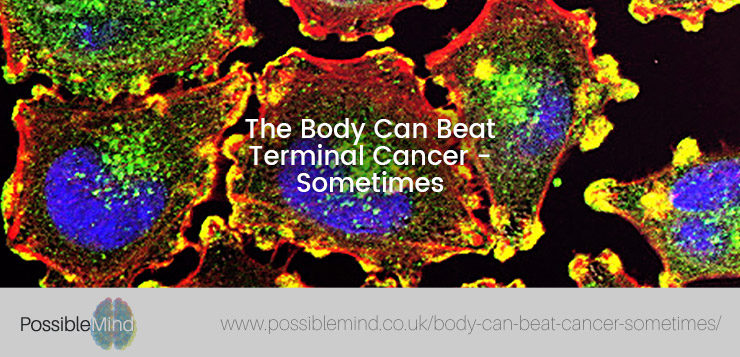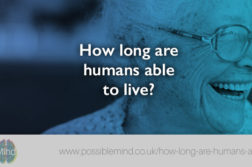They should be dead. But a tiny number of people conquer lethal diseases.
John Matzke was just 30 years old when he was told that he had only 18 months to live. At 6 feet 4 inches tall, with blue eyes and broad shoulders, Matzke cut an impressive figure. He’d been a football player at Dartmouth College, where he studied geology. That was also where he met his wife, Lyn, who worked in town. In 1973, Matzke and Lyn moved to Wisconsin to run a small homestead, where they grew organic vegetables and raised chickens and a pig. Just seven weeks after the birth of his first son, in 1974, Matzke noticed a lump in his armpit. A biopsy showed that the lump was malignant melanoma, a particularly fatal form of skin cancer. He would have that tumor and then a few others removed by surgeons.
By 1984, the cancer had spread to his lung. Having served in the Army’s Fifth Armored Division in Ulm, Germany, Matzke went to the Veterans Administration hospital in White River Junction, Vermont, to see his oncologist, Joseph F. O’Donnell. Knowing that his patient’s chances of surviving the cancer were slim—and would only lessen with each passing day—O’Donnell urged him to undergo immediate treatment. The oncologist told Matzke that once melanoma invades an internal organ like the lung, the invariable outcome is death—usually within months—without immediate treatment. Even with treatment, his outlook was guarded. Only half of all melanoma patients with lung metastases are alive 30 months after surgery.
But Matzke didn’t follow his doctor’s recommendation. Instead, he took a month off to strengthen his body for the treatment that he knew would most likely be a grueling ordeal. He went on long hikes in the mountains, he ate healthy foods, and he meditated. He also spent a lot of time picturing himself healthy and visualizing good strong blood cells destroying the cancer in his body.
Matzke later flew back to Vermont, where O’Donnell repeated the chest X-ray to document the size and location of the tumor before starting treatment. But instead of the large cancerous lesion in Matzke’s lung, he saw . . . nothing. O’Donnell recalls, “When John came back a month later, it was remarkable—the tumor on his chest X-ray was gone. Gone, gone, gone.”
Call it remarkable, call it miraculous—such spontaneous remissions are as fascinating to physicians and scientists as they are rare. Doctors would like to understand cases like Matzke’s, who was given just 18 months to live but would survive another 18 years. And although a recurrence of the cancer—this time in his brain—would eventually claim his life on November 8, 1991, the fact that his lung tumor disappeared completely begs for an explanation.
Pinning down spontaneous remissions has been a little like chasing rainbows. It’s not even possible to say just how frequently such cases occur—estimates generally range from 1 in 60,000 to 1 in 100,000 patients. Many cases, when subjected to close scrutiny, prove not to have been remissions at all. According to Stephen Barrett, a retired psychiatrist who operates Quackwatch, a number of people claiming to have had spontaneous remissions or to have been cured by alternative treatments never had cancer in the first place. Barrett, who has tracked claims of cures through alternative therapies, says some people were given mistaken diagnoses. Other claims, he says, are outright scams, used to promote books and videos that purport to share the secret of curing cancer or AIDS.
But genuine cases do exist, and throughout the history of medicine, physicians have recorded cases of spontaneous remission. Such cases involve not just cancer but conditions like aortic aneurysm, a deadly ballooning of the heart’s major artery; Peyronie’s disease, a deformity of the penis; and childhood cataracts. These cases cause doctors to scratch their heads in wonder at what brought them about. But most of the attention on spontaneous recovery continues to focus on cancer, which takes the lives of over half a million people in the United States alone each year.
Although researchers say it is impossible to determine from a single patient what factors contributed to a spontaneous remission, Matzke’s case provides a tantalizing clue that the immune system may sometimes be at work. During his month of meditation and healthy living, white rings developed around his skin tumors, causing what doctors call a halo sign. These findings are considered evidence that the immune system is attacking melanocytes, the pigmented cells in the skin that are the source of this cancer. While most doctors say it is impossible to know just what causes the immune system to kick suddenly into action and induce a remission in any individual patient, Matzke’s case underscores questions that researchers would like to answer: Did his month of hiking, healthy eating, and meditating somehow strengthen his immune system? Did some as yet unidentified factor make his lung tumor mysteriously disappear?
Today researchers are just beginning to piece together the clues they hope will allow them to see what makes a deadly cancer sometimes reverse course and melt away. Much of their research focuses on the immune system, which they describe as a sort of military unit that protects the body from foreign invaders. T lymphocytes, a type of white blood cell, serve as a frontline defense against invading bacteria and viruses. A subtype of T lymphocyte, known as a natural killer (NK) cell, patrols the body, attacking and killing viruses and cancer cells. Researchers are studying how NK cells recognize cancer cells as abnormal and how other cells, known as regulatory T cells, can command NK cells to hold their fire, in order to prevent them from attacking the body’s own tissues.
Despite the remarkable insights researchers now have about the immune system, it remains a daunting task to develop immune modulators—drugs that can mimic the immune system or trigger it into action. That is because there are a few dozen distinct immune cells that release between 50 and 100 signaling molecules—molecules that tell the other cells what to do and when. When the relationships among these cells and molecules are graphed, the result looks like a plate of spaghetti. Altering the behavior of one cell or molecule can upset the entire system. Barnett Kramer, a medical oncologist and director of the Office of Medical Applications of Research within the National Institutes of Health (NIH), says the complexity of these relationships makes it as difficult to cure cancer with immune modulators as it is to “repair a fine watch with a screwdriver and a hammer.”
Even when the immune system is aided by immune-modulating drugs, cancer remains a wily adversary: Cancer cells can dress up in a clever disguise by cloaking themselves in clumps of platelets (cells that assist in blood clotting) as they travel through the bloodstream. Since the immune system does not normally attack its own platelets, the camouflage provides safe passage to the cancer cells as they migrate to distant parts of the body. According to Robert Weinberg, a leading cancer researcher and founding member of the Whitehead Institute in Cambridge, Massachusetts, a number of “built-in native defenses” usually prevent the development of cancer. For example, the body’s cells can recognize “signaling imbalances” in their own internal circuitry that might cause them to proliferate wildly, causing cancer. When an imbalance is recognized, the bad cells are “hard wired,” says Weinberg, to kill themselves, “to commit suicide.” In the absence of this and other defense mechanisms, Weinberg says, “cancer development would be inevitable, and we would be covered by tumors by the time we’re several years old.”
Because cancers have to trick the immune system and defeat a number of the body’s other defenses in order to grow to the point where they become clinically apparent, it is surprising that some people with late-stage cancers like Matzke’s can undergo spontaneous remission. On the other hand, regression of early microscopic cancers may occur more readily and may be common. A microscopic cancer can be likened to a paper fire in a wastebasket: A small fire may be easily contained and may even burn out without incinerating the house. But once a fire escapes the wastebasket and the drapes and furniture go up in flames, the chances that the house will escape destruction are slim indeed. Even more remarkable is that when the body does somehow induce a late-stage spontaneous remission, sending metastatic cancers spinning in reverse until they vanish, the body not only overcomes the evasions and counterattacks mounted by the cancer, it does so without the terrible side effects that can accompany current cancer treatments. The holy grail of cancer therapy is certainly to find a way to trigger this most remarkable of nature’s defenses. But is it possible?
Life-Saving Infections?
One of the earliest systematic efforts to understand spontaneous remission was made by William Coley, an American bone surgeon born in 1862. Coley was driven to his research following the death of the first patient he would diagnose with sarcoma, a cancer that affects bone and muscle. The patient, 17-year-old Bessie Dashiell, who was a close friend of John D. Rockefeller Jr., came to Coley with pain and swelling in her right hand. When a biopsy revealed that the girl had sarcoma, Coley amputated her arm just below the elbow in a desperate bid to save her life. Despite his efforts, the cancer spread throughout her body, and she died nearly three months after Coley diagnosed her.
Badly shaken by Dashiell’s death, Coley pored over the medical records of previous sarcoma patients. Anecdotal observations of patients dating back to the 1700s had already provided a curious clue that pointed to the immune system as a possible player in the body’s fight to ward off cancer. Doctors noticed that some cancer patients who suffered serious infections recovered from their cancer shortly afterward. This led doctors to infect patients with organisms that cause syphilis, gangrene, and erysipelas—a serious skin infection, known in the Middle Ages as Saint Anthony’s fire, that could invade the lymph nodes, a part of the body’s immune system. Unfortunately, a number of patients died from the infections instead of their cancer; just how many is hard to say since medical studies in the 1800s were not methodical and often consisted of case reports.
Coley nevertheless believed there was something to be gained from such experiments, and so he scoured hospital medical records for cases of spontaneous remission in sarcoma patients. In 1891, when he came across a report of a German immigrant in New York City who had recovered from sarcoma after he developed erysipelas, Coley spent weeks tracking him down among the city’s tenements. When he found the patient quite alive and fully recovered, Coley became determined to test his hypothesis that sarcoma patients could be cured by infection. Coley declared, “Nature often gives us hints to her profoundest secrets and it is possible that she has given us a hint which, if we will but follow, may lead us on to the solution of this difficult problem.”
Coley spent the rest of his career, until he died in 1936, perfecting recipes for a brew of infectious agents and their toxins that could stimulate an immune response—without killing the patient. His efforts met with variable successes and failures. Parke-Davis produced the toxins, then known as mixed bacterial vaccines, or MBVs. By the 1940s—when researchers discovered that a chemical warfare agent, nitrogen mustard, suppressed cancer—chemotherapy with nitrogen mustard and other agents, along with radiation therapy and surgery, began to supplant Coley’s toxins. In 1953 Parke-Davis ceased production of MBVs. Yet as recently as 2005, doctors at Dartmouth and Harvard universities concluded that Coley may have been right that some infections, particularly those caused by Streptococcus, might cause tumor regression. In 1999, a comprehensive review was performed of scientific studies of Coley’s toxins. Scientists found that the 128 patients treated between 1890 and 1960 with Coley’s toxins fared as well as 1,675 similar patients treated with conventional methods in 1983. However, the researchers said the study was small and subject to bias, leaving their findings in doubt. Currently, the toxins are still available on a “compassionate use” basis in nine countries, including Germany and the Bahamas; one clinic in the United States also uses a preparation based on Coley’s toxins.
As doctors and patients have become increasingly aware of the limits of conventional treatments for certain cancers, some doctors are looking back to Coley’s toxins and how nature pulls off its occasional and surprising cures. The hope that a drug or mind-body connection could be used to trigger a spontaneous remission has led researchers to study both the intricacies of the immune system and the mind, and the connections between them.
Looking for Answers: Body and Mind
Studying the immune system’s reaction to cancer is now serious business. Immune modulating drugs targeted to attack certain cancers have achieved blockbuster status in the past decade. Rituximab, a monoclonal antibody that attacks cancer cells in patients with a certain subtype of B-cell lymphoma, was approved by the Food and Drug Administration in 1997. By 2005, sales of rituximab reached $1.8 billion. Researchers at biotech companies around the globe are devoting their careers to the development of other immune modulators, and a number of new agents are in the pipeline.
While Weinberg acknowledges the contribution made by Coley in instigating current research into the immune system as a way to fight cancer, he cautions that beyond Coley’s original observation that there is a connection between the immune system and cancer, there is little to be learned from the rare instances of spontaneous remission. First, he says, it is hard to find real cases, since many turn out to be “hokum.” He adds, “If you look closely at these cases, you find [many]were dissembling.” Weinberg, a middle-aged man with a trim mustache and a formal but genial manner, says it is impossible to learn lessons that can be generalized to most cancer patients from rare and idiosyncratic cases of spontaneous remission. “We need to work with reproducible phenomena that we can [test]5, 10, 100 times over to verify the results,” Weinberg says.
Performing scientifically sound experiments that can be reproduced over and over is exactly what Weinberg and his colleagues are doing. Antoine E. Karnoub, another researcher at Whitehead, performs experiments on living human and mouse cells that are kept in a freezer packed with liquid nitrogen. When he opens the freezer lid, white clouds escape. Karnoub quickly closes the lid and explains that the human cells he tests were removed from patients during surgery or from biopsy specimens. Many of the human donors died decades ago, but their cells are kept alive and reproducing so that Karnoub and others can test them and observe their interactions with the body’s natural defenses. Eventually, says Weinberg, the scientific insights learned from researchers like Karnoub may help others develop anticancer drugs.
Other mechanisms besides the immune system may also play a role in spontaneous remission, according to Caryle Hirshberg, coauthor of Spontaneous Remission: An Annotated Bibliography and a consultant for the Institute of Noetic Sciences (the term “noetic” here relates loosely to mind-body connections). The bibliography provides the most comprehensive review available of the published literature on spontaneous remissions. Reports included in the bibliography indicate that some cancers regressed after they outgrew their blood supply and underwent necrosis, or tissue death. This observation led researchers to develop antiangiogenesis drugs that inhibit the growth of new blood vessels. Bevacizumab, the first angiogenesis inhibitor approved by the FDA, is in use now to treat colon cancer. Other patients improved when they experienced changes in their estrogen, thyroid, or growth hormone levels. Some patients improved after marked temperature elevations, with or without infection. Finally, a number of reports suggest that some emotional, spiritual, or mind-body connection may have induced a spontaneous remission.
The scientific evidence that mind-body connections might induce self-healing is limited and conflicting. Nonetheless, some patients and physicians believe the mind plays a powerful role in both the development of cancer and its treatment. Alice Epstein, a mathematician and sociologist, was diagnosed in 1985 with cancer of the kidney and told she should have her left kidney removed right away. One month after having her left kidney removed, the cancer spread to both her lungs, and she was informed she had just two to three months to live. Like Matzke, she was advised to undergo immediate treatment. Epstein, who says she had a “cancer-prone personality,” then turned to psychosynthesis, which she describes as a “combination of psychotherapy and spiritual therapy.” It helped her overcome depression, difficulty expressing anger, and suppression of her own needs in order to please others—traits she and some psychologists believe are characteristic of the cancer-prone personality. Although she never received any medical or surgical treatment for the deadly cancer invading her lungs, six weeks after starting psychosynthesis, her tumors began to shrink. Within one year, they had disappeared without a trace. That was 22 years ago. Epstein, now healthy and 80 years old, tells her story with good-natured grace. But she acknowledges that despite contact with many other people with cancer, she has not met anyone who had a spontaneous remission as she did, despite their efforts.
The problem with anecdotes is that they can so easily mislead; it doesn’t take long to find anecdotes that tell a different story. Dr. O’Donnell recalls a patient of his with metastatic colon cancer. The patient, whom we’ll call Don R., was told by his surgeon he had just six months to live. O’Donnell says R. became so distraught that he constantly checked the calendar on his watch, and as each new month ticked forward, he grew more and more anxious. On the night his watch was to tick forward to the six-month mark, O’Donnell had to hospitalize R. for his distress. He placed the patient directly across from the nursing station where he could be closely monitored. The man lived through the night—and went on to survive another 14 years, as his cancer never progressed (he eventually died of a pulmonary embolus). But for those 14 years, R. continued to check his calendar anxiously for the passage of every month. O’Donnell says he tells this story as a reminder of how difficult it is to make a precise prognosis, but R.’s story also challenges assumptions that anxiety and stress lead to a bad outcome while positive feelings automatically bring a positive outcome.
Doctors know that case reports can lead to flawed conclusions. Cause and effect can be confused. Unrelated events may be thought to be related. If, as some people believe, the mind can have a positive influence on the immune system—which in turn can fight off cancer—it would stand to reason that R., who was terribly stressed, might have been expected to do very badly. On the other hand, patients like Matzke and Epstein could skew perceptions about mind-body effects through a form of reporting bias called the survivor effect. The survivor effect occurs when only surviving patients tell their stories, leaving out those patients who may have tried positive thinking or prayer but died. Collections of such case reports can be highly misleading. To determine whether an intervention is truly effective, researchers must perform clinical trials that compare all patients treated with an intervention. Unfortunately, there are few such studies, and those that exist have led to conflicting results.
The most celebrated study showing a dramatic reduction in mortality with psychological support was performed by David Spiegel, a professor at the Stanford University School of Medicine. Spiegel’s study, published in 1989 in The Lancet, showed that women with terminal breast cancer who were enrolled in supportive therapy had a significant survival advantage over women who were not enrolled in support groups. But several well-performed studies since 1989 fail to reproduce the finding. A study published in The New England Journal of Medicine (NEJM) in 2001 found no survival benefit for the 158 women randomized to support groups compared with the 77 women who were not enrolled in the groups. It did, however, show that women who were in support groups experienced an improved quality of life.
None of the patients from the groups could be interviewed because they have all died, and the groups were disbanded at the end of the study, according to Patricia Fobair, who co-led the support groups with Spiegel. Fobair, a clinical social worker who was herself diagnosed with breast cancer in 1987, recalls one of the group patients, an engineer, who came to the group depressed and with marital problems. With encouragement from the support group, the woman went back to school to become an artist, resolved her marital problems, and became someone who was “fulfilled,” according to Fobair.
Despite conflicting study results, doctors agree that our minds clearly do have some effect on our physiology and overall health. When frightened, our hearts race, our palms become sweaty, and our pupils dilate. Stress can cause changes in the function of the immune system, including reducing the number of natural killer cells that are known to battle cancer. An entire field of study called psychoneuroimmunology now examines such connections. Weinberg, who says he used to doubt claims that mental states could affect the course of cancer, now wonders. To show why, he pulls out a raft of study results collected in a large three-ring binder and points to several studies showing that mice subjected to stress developed more cancers than normal mice. The effects of stress can be profound. A fascinating study published in NEJM last year found that the newly bereaved—those who had lost a husband or wife within the past month—have a 53 to 61 percent increase in the risk of death.
Yet attempts to harness the power of the mind or spirit to induce self-healing through techniques like prayer, support groups, therapeutic touch, and meditation have been largely disappointing. For example, doctors at Duke University thought that prayer might help patients who were undergoing cardiac surgery for stent placement. But when they concluded a multicenter study of intercessory prayer for their patients, there was no reduction in six-month mortality. Similarly, a study of “therapeutic touch” published in the Journal of the American Medical Association showed that practitioners who insisted they could sense a patient’s “energy field” proved incapable of even sensing the presence or absence of a test subject’s hand. In that study, therapeutic touch practitioners, prevented from visually observing the subject’s hand, were able to locate the hand correctly in only 122 of 280 test runs—44 percent of the time, a rate roughly equivalent to chance alone (50 percent). The authors of a 2006 study published in the Journal of Clinical Oncology did find that breast cancer patients who had more social ties survived longer than did socially isolated women. However, the authors concluded that socially isolated women fared worse because they had less access to medical care.
When patients do better, there is a temptation for doctors—whether they practice alternative or conventional medicine—to take credit for such outcomes. Kramer of the NIH says, “There is a tendency to believe that whatever you did caused the response, whereas we underestimate the natural course of the disease.” The fact that some patients do better or experience a regression following a seemingly useless treatment has raised questions about a possible placebo effect. Exploiting the placebo effect is explained by Campbell Murdoch, who writes in the British medical journal BMJ, “Another reason for using so-called ineffective treatments is to allow time to pass while the patients get better. Cold bottles were not treatments, they were like egg timers. You gave the patient or the parent an ineffective colored liquid in a bottle and asked them to take 5 ml four times a day out of it. By the time the bottle was empty, the patient was better, not because the contents worked, but because time had passed. It was effective, but for the wrong reason.”
But if a (useless) treatment is not the cause of an improved outcome, could the placebo effect explain some cases of spontaneous regression? It appears unlikely, since that effect would be expected to work through the same pathways already being tested with various mind-body techniques. If the placebo effect were at work, it should be observed in positive outcomes among people who join self-healing groups, pray, or visit Lourdes. Yet despite intense interest in such cures over the millennia, whether religious or secular, scientific or mystical, none of the approaches based on mind or spirit has proven to be particularly effective. Even the famed Lourdes, with over 1 million visitors annually, boasts only a few dozen “miracle cures” ever, according to the Vatican—leaving vast numbers of pilgrims to cope otherwise with cancer and other serious illnesses.
Underestimating Spontaneous Regression
While late-stage spontaneous regressions are as rare as hens’ teeth, early spontaneous remissions of microscopic cancers may be quite common—and their frequency may have been underestimated. And that might be causing an unexpected problem. With the advent of new technologies, like CT scans, MRIs, and more sophisticated blood and urine tests, doctors are discovering many cancers at very early stages. At first, doctors and patients welcomed early diagnosis, assuming that early detection would lead to improved survival. But that assumption can cause “medical mischief,” according to the NIH’s Kramer, who says that detecting such early-stage cancers can cause more harm than good if the cancer cells were unlikely to have caused a problem over the person’s lifetime. This, says Kramer, is especially true with prostate cancer and some melanomas and breast cancers that may never go on to cause harm. In those cases treatment offers none of the benefits while exposing the patient to the measurable harms of surgery, chemotherapy, and radiation therapy.
As the “medical mischief” caused in part by an underestimation of the frequency of early spontaneous remissions has become apparent, doctors have had to abandon several cancer screening programs. For example, when researchers developed a simple urine screening test for neuroblastoma—a childhood cancer that arises in immature nerve cells—officials in Japan launched a public health campaign to screen infants. By 2001, over 90 percent of infants were being screened. When the cancer was detected, the children were treated with surgery, radiation, and chemotherapy. But as it was later learned, many of the babies had a slow-growing form of neuroblastoma that would either cause no problems or disappear spontaneously. Worse, the interventions did not reduce the number of deaths from neuroblastoma—but the unnecessary surgeries and treatments did cause some deaths, leading authorities to halt the program. Similar concerns are now being raised about prostate and breast cancer screening programs that detect many slow-growing, less aggressive cancers that are generally more common in older patients than the more aggressive forms of breast and prostate cancer that tend to occur in younger patients.
Like many areas of medicine, progress comes in fits and starts. At the same time that mistakes are made, small triumphs are achieved. Coley’s legacy lives on in the bacillus Calmette-Guérin (BCG) vaccine now in use to treat some forms of bladder cancer. Doctors instill the bacillus into the bladders of patients who have been treated for superficial bladder cancer. The bacillus provokes the immune system to produce an inflammatory response that in turn prevents cancer recurrence. Derived from a bovine form of tuberculosis, BCG is used as a vaccine against TB in many parts of the world.
Although medical advances have dramatically improved outcomes in certain cancers—treatment of testicular cancer and childhood leukemia now routinely lead to cures—when it comes to many other cancers, modern medicine has yet to come close to nature’s handiwork in inexplicably producing spontaneous remission without apparent side effects for people like John Matzke and Alice Epstein, who have experienced the rarest hints of nature’s healing mysteries.
This article was written by Jeanne Lenzer and was originally published on August 21, 2007 at www.discovermagazine.com.
If you like this post you will also enjoy:
- Imagery Can Help You Recover from Injuries and Illness – Learn Mind Power With John Kehoe.
- Mind Power and Belief for Recovery and Healing.
- How Athletes Recover Quicker Using Mind Power.
- The Healing Power of Illness Book Overview.
Further Reading:






